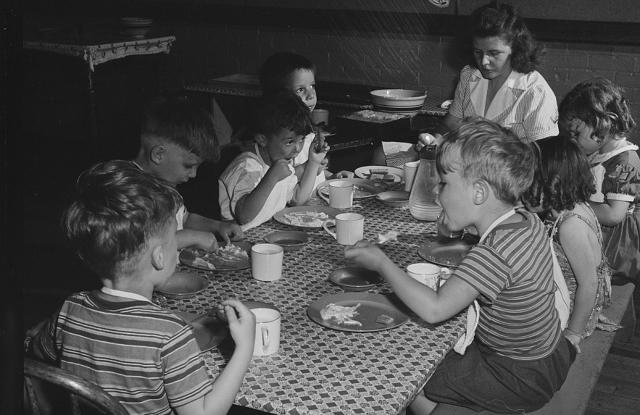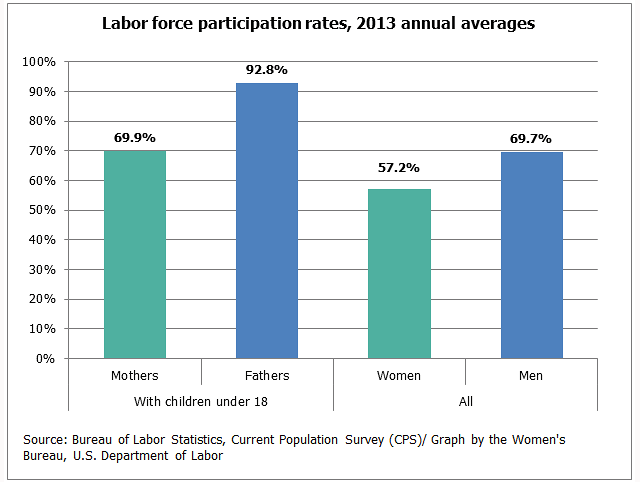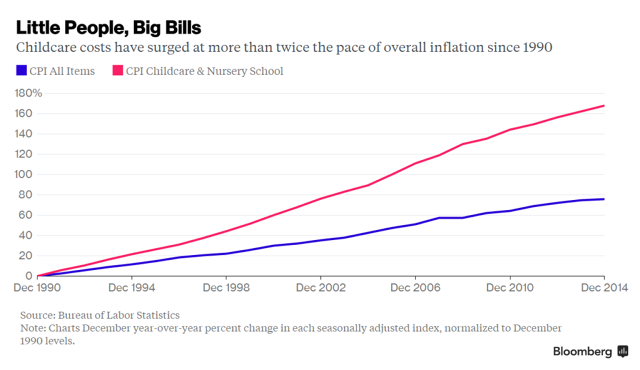76 years in the past, the U.S. had a government-funded universal child care machine. Can it ever occur once more?
Day care costs greater than college training in most states in the usa.
This high cost regularly finally ends up being as regards to or more than the take-home pay of many parents, and due to the power gender pay hole, that father or mother is most frequently the mother. which means extra ladies are quitting their jobs or scaling again their hours after they have children. On reasonable, professional girls lose round $11,000 a 12 months, due to the gender pay gap, which can be the common annual price of child care within the U.S., and after decades of decline and a drop to 23% in 1999, the proportion of stay-at-home moms rose to 29% in 2012.
nevertheless it hasn’t at all times been this fashion.
1940s: The economy needed women Working and girls wanted child Care
Seventy-six years in the past, the U.S. had a executive-funded child care gadget for working parents. in line with the demands of the safeguard industries best up to and during World war II, Congress handed the defense Housing and community services and services Act of 1940. The law funded public works, together with youngster care centers, in communities with defense industries. households had been eligible for youngster take care of up to six days per week, together with summers and holidays, and fogeys paid the equivalent of simply $9–$10 a day in these days’s greenbacks. throughout the lower than 10-yr run, these govt-run daycare centers served greater than one hundred,000 children from families of all incomes.
There was once a necessity for subsidized child care as a result of, as we all know, for the primary time in U.S. historical past, both men and women had been being encouraged to enter the staff. In 1940, when the legislation used to be passed, handiest 28% of girls have been working, but by 1945, greater than 34% of girls have been in the staff. And the federal government realized that with two folks working outside the house, it used to be a social duty to offer affordable (and high quality) kid care, just because it’s a social responsibility to offer free public school for older kids. however aside from that, there was once additionally an economic motivation for the government to subsidize kid care: It wanted ladies within the personnel, simply as the economy does now.

which you could bet what came about subsequent. After World conflict II ended, the safety jobs dried up, and ladies have been largely pressured out of (or chose to depart) the team of workers. actually, greater than half of of the women drawn into the group of workers with the aid of the battle left on the finish of the Forties. And with these jobs went the sponsored youngster care. it would be a long time before Congress would move any other common youngster care invoice.
Seventies: A chance To “conventional family constructions”
In 1971, Congress passed the excellent kid development Act on a bipartisan vote. The act dependent a community of nationally funded, locally administered kid care facilities that would provide education, diet, and clinical services and products. Minnesota Senator Walter Mondale seen the measure as a first step toward national, universal youngster care. The facilities can be open to all on a sliding-scale basis, which means that unlike most different child care initiatives we’ve seen in additional latest years, it will lend a hand ease the burden on youngster care prices on middle category and bad households alike. the amount that Congress authorized for the program would have made a real distinction—in nowadays’s dollars, it was the identical of 5 times the 2012 federal price range for Head begin.
despite early support from officials in his administration, President Nixon vetoed the invoice because of conservatives’ issues that subsidized child care would undermine conventional breadwinner-homemaker household constructions. The veto also came as the cold warfare raged, when fears of a communist option to social services have been at their peak.
lately: Falling some distance at the back of Our peers
now we have moved far from the specter of communism, however many americans nonetheless affiliate social packages like common health care and child care as something discovered handiest in socialist nations. Many Scandinavian countries have long had nationwide paid parental leave packages in addition to guaranteed child care for all children over a year outdated.
nevertheless it’s not just a smattering of Nordic nations that do: All of the U.S.’s developed friends have a long way higher paid parental go away policies as well as generous youngster care advantages equipped through a mixture of government products and services, unions, and organisation funding (and to a a lot smaller extent, paid for with the aid of the fogeys themselves). to place it in viewpoint, a 2011 document from the organization for financial Cooperation and development (OECD) found that two-earner households within the U.S. pay more than double for youngster care than virtually every different united states on the checklist, together with Germany, Australia, France, and Greece.
within the forty five years since the complete kid construction Act used to be defeated, the issue of universal youngster care has never been introduced up in a significant approach again. President Obama has talked about the problem (or parts of it) a couple of occasions through the years, most notably in 2013, when he introduced a concept for a 10-yr, $seventy five billion investment in common pre-kindergarten for all four-12 months-olds. while that measure never passed (the funding would have been financed by way of greater cigarette taxes, which met political resistance), greater than half of U.S. states have considering that raised their very own money for state govt–funded pre-ok.
but whereas the solution to care for and train kids for 12 months prior to they start basic college definitely has its benefits, a patchwork state-by using-state device turns this kind of crucial care into good fortune of the draw. It also does nothing for the first four years of a kid’s life.
That duration is a essential time for construction and sets children on the path to the sorts of adults they’ll become. according to “The Hell of american Day Care” by means of Johnathan Cohn, revealed in the new Republic in 2013, researchers have found out that what happens in the first few years of lifestyles affects the architecture of a kid’s brain in ways that form both mental abilities and behavior. “kids who grow up in nurturing, interactive environments are inclined to develop the skills they wish to thrive as adults,” studies Cohn.
Our Lingering Denial
for the reason that Forties, the U.S. has executed subsequent to nothing to take care of kids under four. There are few packages aimed at the very terrible: Head begin, which commenced in the 1960s with preschool-age children, now bargains some measure of assistance to children beginning when they’re infants, however is usually restricted to those in foster care or who are homeless. there is additionally a child care tax credit (which Obama has also tried unsuccessfully to raise right through his tenure), but it maxes out at $1,000 (or about 9% of the average value of day care in the U.S.), and only low-profits folks qualify.

however as we noticed within the Nineteen Forties, the government is capable of agreeing on subsidized child care when it’s evident that it’s a priority as a way to preserve girls in the team of workers. Many signs level to that point being lengthy late. the necessity for youngster care is a permanent reality within the U.S.: in line with the division of Labor, 57% of ladies work (a share just about equal to men), and nearly 70% of girls with kids under 18 work outdoor the home.
a part of the problem seems to be that while the majority of mothers work out of doors their houses, we still have hassle accepting that the modified panorama of the American family should have additionally include a metamorphosis in how the u . s . a . views the accountability of kid care.
after all, the primary argument in opposition to govt-backed youngster care is that caring for one’s youngsters is a non-public accountability, and the burden shouldn’t fall on the shoulders of folks that make a choice to not have kids. yet we’re at ease paying for many social applications that can by no means benefit us immediately: Social security, pensions, public housing, public schools, libraries, well being care. As Cohn points out in his article:
youngster care is the most important unfinished part of that challenge. the shortage of high quality, inexpensive day care is arguably the most important barrier to full equality for girls within the place of work. It makes it extra seemingly that children born in poverty will stay there. That’s why other developed countries made youngster care a collective duty long ago.
France can serve as a just right instance of what that “collective accountability” looks as if. There, quality kid handle little ones through tots is sponsored by means of the federal government, and households pay in accordance with a sliding scale. Unsurprisingly, eighty% of French girls work. the price? The French govt devotes about 1% of GPD to youngster care, greater than twice as much as the us does.
without intervention, the issue of child care costs within the U.S. will handiest get worse. in keeping with a Bloomberg file last August, weekly day care costs for youngsters 5 years previous and youthful rose virtually 50% between 1990 and 2011, and the fertility price in the U.S. is on the upward thrust as millennials enter their high childbearing years (in 2014 the full collection of births in the U.S. increased for the primary time on the grounds that 2007). extra births imply an increased demand for day care, with a view to continue to power costs up.

but investing in youngster care isn’t simply crucial to maintain girls in the workforce (which has proved to be just right for trade: an excellent gender break up at one firm contributed to a 41% raise in earnings), it’s also imperative to the overall health of the financial system. From the new Republic:
James Heckman, the Nobel-successful economist, has calculated that, in the very best early childhood applications, each greenback that society invests yields between $7 and $12 in benefits. When youngsters develop as much as grow to be productive contributors of the staff, they feed more money into the financial system and pay more taxes. in addition they price the state much less—for journeys to the E.R., special schooling, incarceration, unemployment benefits, and different bills that have been linked to inadequate nurturing within the earliest years of life. Two Fed economists concluded in a record that “the most efficient manner to lift the productivity of the personnel 15 to 20 years down the road is to invest in these days’s youngest children” and that such spending would yield “a so much better return than most executive-funded economic construction initiatives.”
The crushing value of kid handle most U.S. families has most effective been talked about in passing by the Democratic candidates, and whereas he made a nod to it in his closing State of the Union handle last week, President Obama seems to have dropped the difficulty from his end-of-time period agenda. the entire Democratic presidential candidates have stated that , however none have made severe point out of tackling the financial burden that rests on working oldsters’ shoulders for a much longer time frame.
universal kid care would not need to be the polarizing political problem that it is become. Most americans would agree it will be important that women keep in the group of workers, that company earnings and the economic system develop, and that the subsequent technology of staff grow up to be healthy and productive. there are many viable, person options for each and every of those concerns, but only one who’s been proven to sort out all three, and it is slipped thru our fingers twice. in all probability the 1/3 are attempting’s the allure.
associated: What Netflix’s wonderful New unlimited Parental go away coverage in reality manner
(44)
